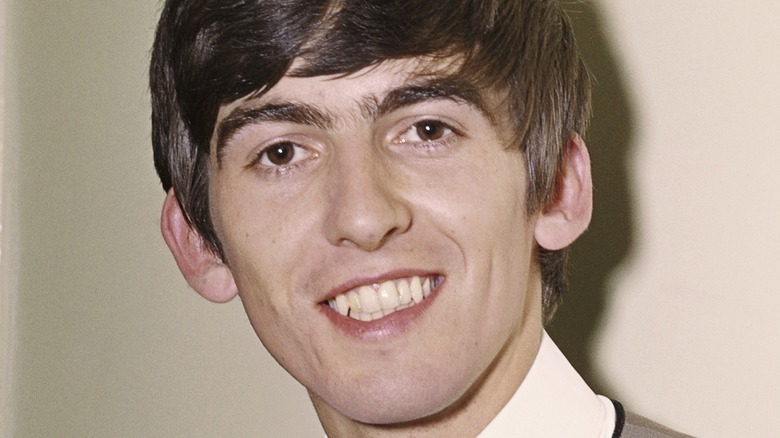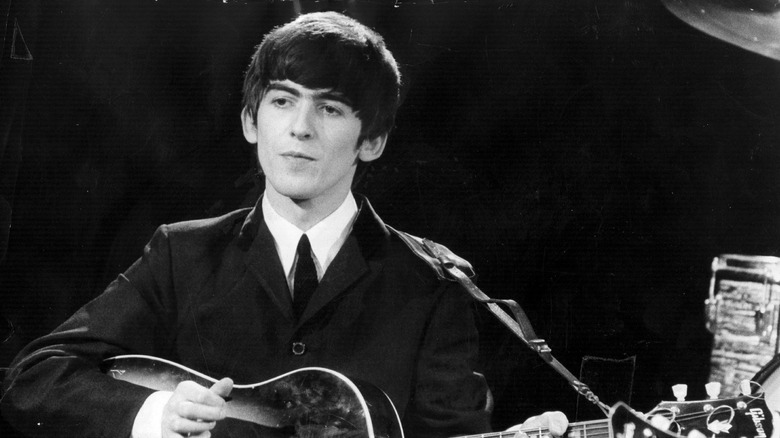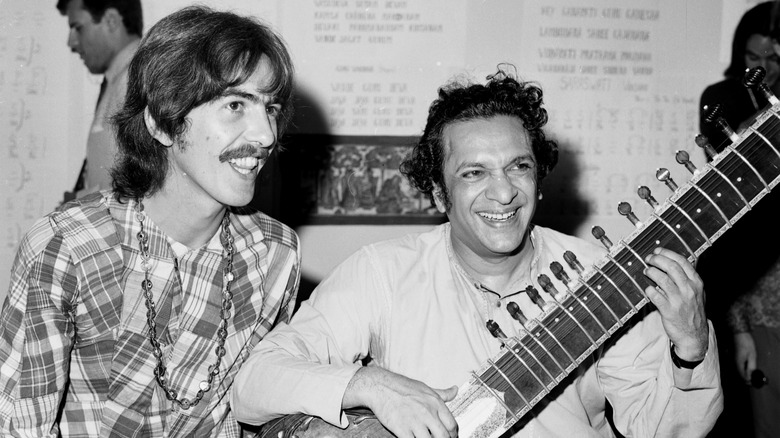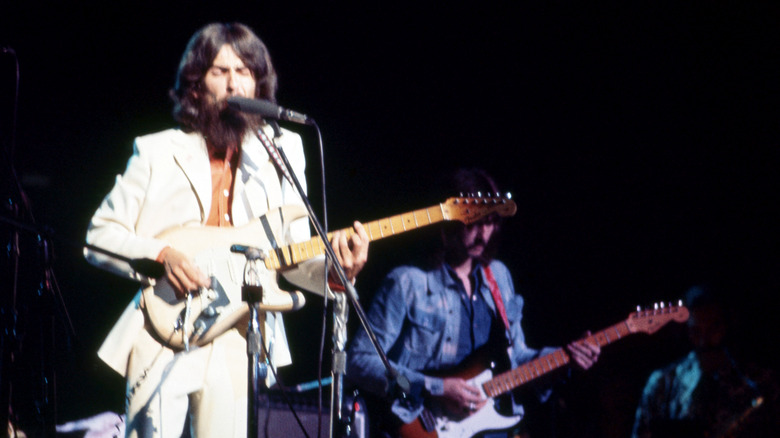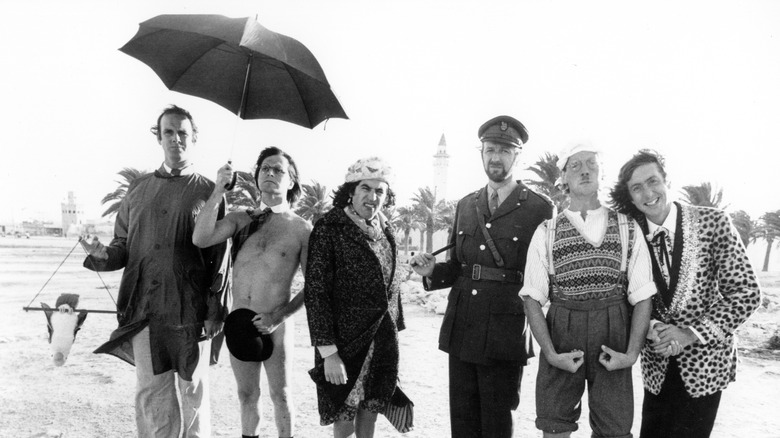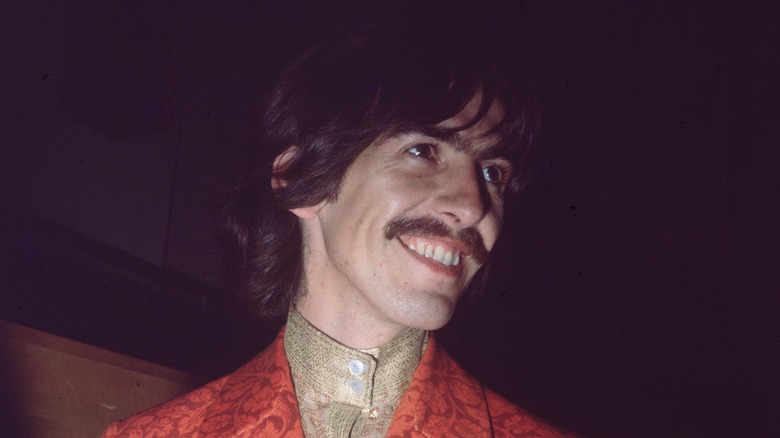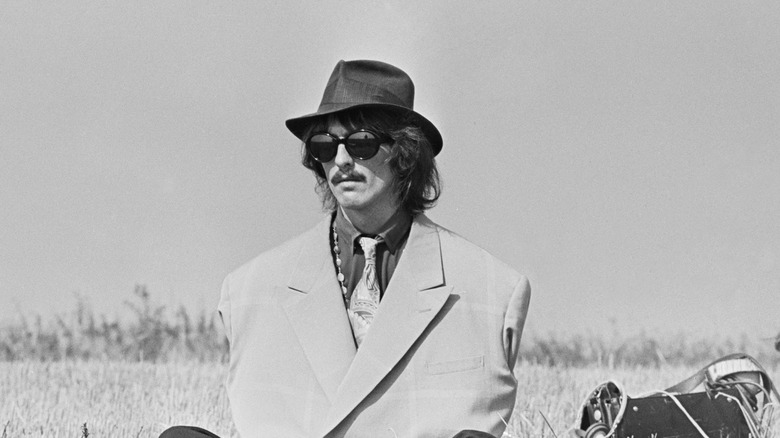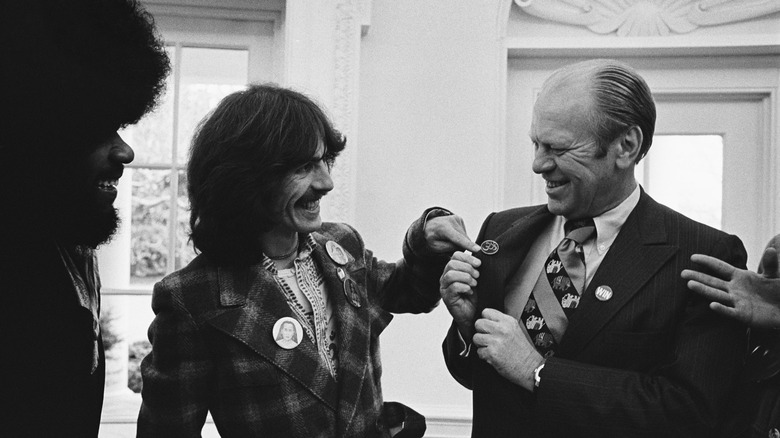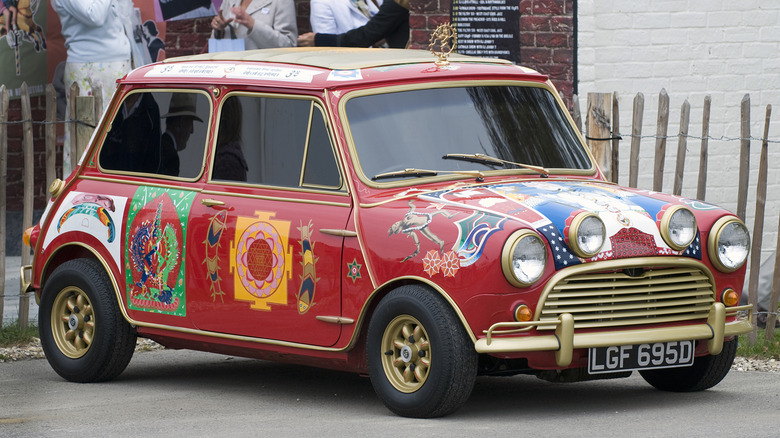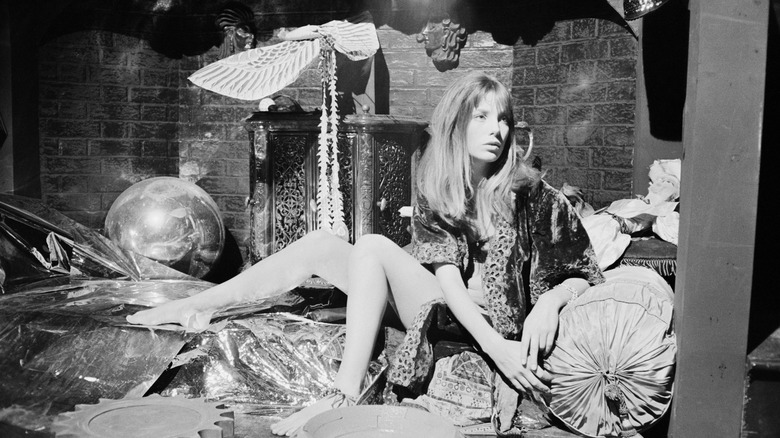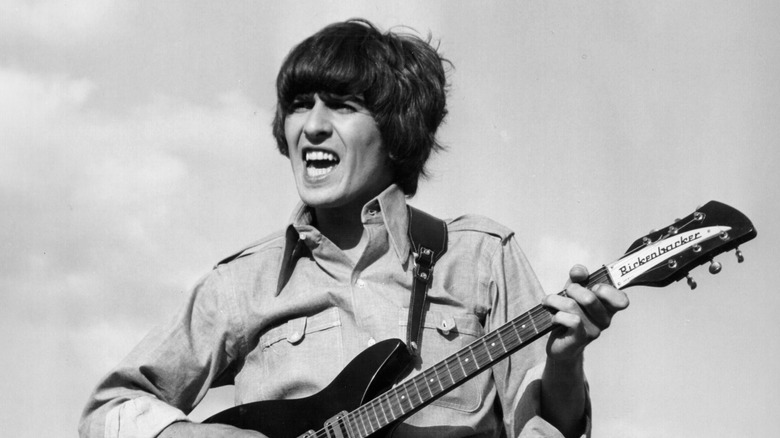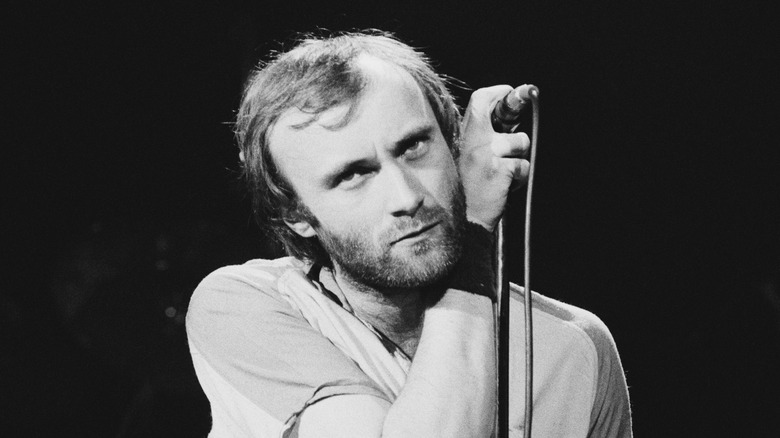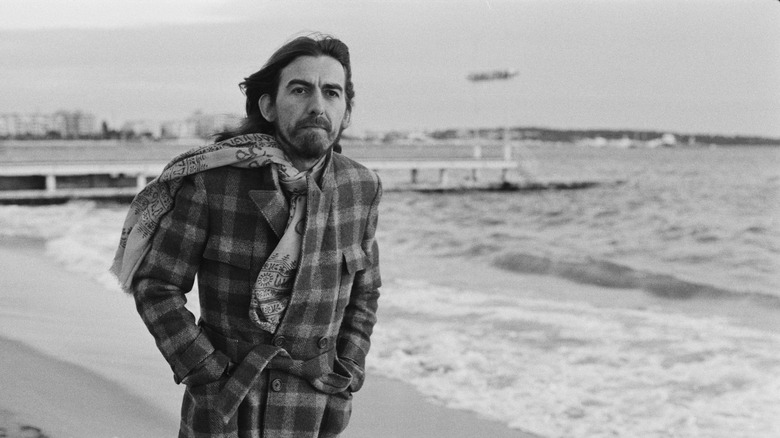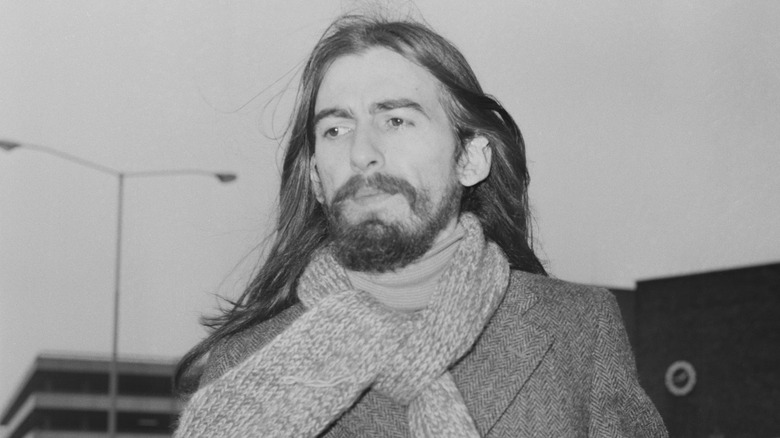The Untold Truth Of George Harrison
Today, we tend to just think of the Beatles as "one of the most famous rock bands of all time" — but while the group was active, each member had a distinct persona. As outlined by the Chicago Tribune, Paul was the Cute One, John was the Smart One, Ringo was the Funny One, and George was the Quiet One. Yet there was much more to the youngest Beatle than meets the eye. In addition to playing guitar with the Fab Four, he had a successful solo career, developed a deep interest in Eastern music and mysticism through a friendship with sitarist Ravi Shankar, held the first-ever major benefit concert, and even produced nearly two dozen films. And that's only the tip of the iceberg.
Want to know what "A Day in the Life" of George Harrison was like? Ready for a "Magical Mystery Tour" through his world? Read on for some little-known facts about the artist.
George Harrison's first song was written during a bout of sickness
Most Beatles songs were written by John Lennon and Paul McCartney, yet George Harrison chimed in every now and then, too. The first song he penned for the band was "Don't Bother Me," featured on sophomore LP "With the Beatles." According to Showbiz Cheat Sheet, the track has an interesting backstory — it was written during a bout of sickness.
While Harrison was on tour in 1963, he came down with a bug. Quarantining himself in his hotel room, he lay in bed with his guitar and started strumming to pass the time. He then decided that he would write a song "as an exercise to see if [he] could" — and sure enough, he accomplished his goal.
In retrospect, Harrison doesn't hold the track in the highest esteem. "I didn't think it was a particularly good song," he later recalled. Nevertheless, it was an important step in his musical journey: "But at least it showed me that all I needed to do was keep on writing and maybe eventually I would write something good."
He was taught sitar by Ravi Shankar
According to Pitchfork, George Harrison appreciated the sitar from early on in his career, picking it up after seeing one on the set of the Beatles' 1965 film "Help!." He used the Indian instrument in the Beatles' "Norwegian Wood (This Bird Has Flown)," ushering in a new era of Eastern-inspired rock music in the West. The song did well on the charts, but famous sitar player Ravi Shankar was unimpressed with Harrison's simplistic playing, which just echoed the main melody. "If George Harrison wants to play the sitar, why does he not learn it properly?" he said.
Eventually, Shankar and Harrison crossed paths — and the two musicians clicked immediately. Shankar offered to instruct Harrison, and Harrison gladly accepted. Soon, he was learning not only about the proper playing techniques but the instrument's spiritual significance in Indian culture. When the rest of the world moved past the "fad" of Indian influences on Western music, Harrison remained invested in Eastern music and musicians. He even helped to finance and distribute "Raga," a 1971 documentary about Shankar's life.
His Concert for Bangladesh was the blueprint for the benefit concert
George Harrison's interest in the sitar came at a time of great strife in South Asia. Some backstory: As reported by Pitchfork, "the Indian subcontinent had been divided into two independent nations in 1947 after decades of British colonialism," resulting in India and Pakistan. Subsequently, Pakistan was split into "two non-contiguous territories, one on each side of India": East Pakistan, which had a "slightly larger population," and West Pakistan, where "the government was based." In March 1971, East Pakistan declared independence as the nation Bangladesh. In response, West Pakistan began a vicious military genocide, killing between 300,000 and 3 million Bengalis and forcing millions of refugees to migrate to India.
Ravi Shankar, a Bengali, was eager to help with the situation. He asked Harrison if he would be interested in planning a concert to raise funds for the refugees, and the former Beatle jumped on board.
The Concert for Bangladesh — the first-ever benefit concert of its scale, according to Far Out Magazine – was held at Madison Square Garden on August 1. It was a star-studded affair, featuring musicians like Bob Dylan, Ringo Starr, Leon Russell, Billy Preston, Eric Clapton, Klaus Voorman, Badfinger, and, of course, Shankar and Harrison themselves. The show raised almost $250,000, all of which was donated to UNICEF. When asked afterward why he had gotten involved with the Bengali cause, Harrison simply answered. "Because I was asked by a friend if I would help."
George Harrison doubled as a film producer
Music wasn't George Harrison's only interest. He also founded a production company, HandMade Films, with his business manager, Denis O'Brien. The company got its start with quite the iconic project — Monty Python's "Life of Brian."
According to The Guardian, Harrison wasn't involved with "Life of Brian" from its inception. At first, it was an EMI production — but the company's chairman, Lord Delfont, "was so appalled" by the screenplay "that he washed his hands of the whole outrageous venture," leaving the Pythons to finance the film themselves. Eric Idle, a Monty Python Member, called up Harrison, a friend of his, to see if he would be interested in helping out. Harrison — a major fan of the Pythons' work — consulted with O'Brien, who was all for it. Harrison had to remortgage his mansion in Henley-on-Thames to make the film, but that was a small price to pay in order to be able to watch a new Monty Python movie on the big screen.
HandMade released several films that are now considered British cinema classics, such as "The Long Good Friday," "Time Bandits," "Mona Lisa," and "Withnail and I." Many of these films featured first-time directors or actors who were just starting out, and many had also been dropped by other studios. "If something's really good," Harrison once professed, "it deserves to be made." Harrison truly committed to this philosophy — according to HandMade's official website, he produced 23 titles with the company.
He once performed as a pirate
Even before his work on "Life of Brian," George Harrison was close with the Monty Python members. In fact, as reported by Rolling Stone, he made a cameo on the 1975 Christmas special of Eric Idle's TV program "Rutland Weekend Television" long before "Life of Brian" was released. He plays himself in the episode — but with a twist. He appears sporting a pirate hat, an eyepatch, a parrot on his shoulder, and a peg leg, insisting that his name is "Pirate Bob." Throughout the show, he interrupts various sketches with the intention of showing off his marvelous acting skills — but time and again, Idle emphasizes that he just wants Harrison to be himself.
At the end of the episode, Harrison finally appears sans the pirate garb, guitar in hand. He strums out the beginning of his hit single "My Sweet Lord" ... and then, over the song's gentle opening chords, he barks, "I like to be a pirate, a pirate's life for me!" What follows is a rousing performance of an original sea shanty written by him and Idle.
Harrison founded his own record label
George Harrison's recording contract with EMI (which had been orchestrated by Brian Epstein during his time with the Beatles) ended in 1976. Harrison prepared for the next chapter in his musical career in advance by creating his own label, Dark Horse Records, in 1974. According to the label's official website, the artists that Harrison signed were "Ravi Shankar, the band Attitudes (with friend Jim Keltner), the duo Splinter from South Shields (produced by George), R&B vocal group The Stairsteps, ex-Joe Cocker guitarist Henry McCullough and a California band named Jiva." Harrison himself also recorded six albums via Dark Horse from 1976 to 1992. Many of the songs on these albums were featured in productions by HandMade Films.
Today, Dark Horse "has come full circle" and has been merged with EMI/Parlophone since 2002. It is led by George Harrison's son Dhani Harrison as well as manager David Zonshine and, per music publishing company BMG's website, recently teamed up with BMG to release new recordings from the back catalogues of George Harrison, Joe Strummer, and Tom Petty.
President Ford's son was a major fan of his music
George Harrison had some pretty prominent fans — including Jack Ford, President Gerald Ford's son. As detailed by the White House Historical Association, on November 16, 1974, Jack, a forestry student at Utah State University, attended Harrison's concert in Salt Lake City and then made his way backstage to introduce himself to the musician. After a warm chat, Ford invited Harrison and his friends and colleagues to visit the White House. Thus, on December 13, 1974, Harrison, his father Harry Harrison, Ravi Shankar, keyboardist Billy Preston, saxophonist Tommy Scott, manager Denis O'Brien, and publicity agent Michael Sterling, arrived at 1600 Pennsylvania Avenue.
According to Rolling Stone, the tour began with a "lunch of beef and vegetables" in the solarium, set to the sound of Harrison's album "Dark Horse." Then Jack and his sister Susan led the group around the White House, concluding with a visit to the Oval Office for an informal meeting with President Ford. Ford gave Harrison a pin for his "WIN: Whip Inflation Now" campaign. In return, Harrison gave Ford an "Om" pin representing his appreciation for Eastern spirituality.
Reflecting on the experience later, Harrison spoke kindly of Ford: "He seemed very relaxed. He was much easier to meet than I would expect. You can imagine the number of things he's got on his plate."
He loved cars and Formula One racing
You know that George Harrison played on "Drive My Car," but did you know he was also a massive car enthusiast? It's true — according to GQ, he bought and sold his cars with such "frenzied abandon" that nobody knows exactly how many he ever owned. Yet the article lists a few of his most notable automobiles, including the green Ford Anglia 105E that served as his first car, a black Jaguar E-Type that Brian Epstein allegedly gave him for his 21st birthday, a white 1964 Aston Martin DB5, a white Mercedes 3000 SEL, a black Mercedes 500 SEL AMG, a dark purple pearl McLaren F1, and, last but not least, the psychedelically decorated Austin Mini Cooper S that was featured in the Beatles film "Magical Mystery Tour."
Harrison didn't just collect cars. He was also a fan of Formula One racing — to the extent that he once spent months following the Formula One World Championship across the globe. Auto 123 reports that he even wrote a song about his passion for racing: "Faster," whose title he took from the published diary of race car driver Jackie Stewart. The song included a recording of the engines at the start of the 1979 British Grand Prix and was released as a single to raise money for the Gunnar Nilsson Cancer Fund, which was founded in 1978 after the death by cancer of the Swedish driver of the same name.
He wrote the soundtrack for the film that inspired Wonderwall
Almost everyone knows "Wonderwall," the Oasis single that took the world by storm in 1995. Not everyone, however, knows the story behind the hit — or George Harrison's surprising connection to it.
According to Mic, Oasis' Liam and Noel Gallagher were major fans of the Beatles — Noel Gallagher even said, "The Beatles are, to me, the be-all and end-all" in 1995. The title of the duo's most famous song is a reference to the 1968 psychedelic film "Wonderwall," George Harrison's first post-Beatles project. As detailed in The Dissolve, "Wonderwall" was directed by Joe Massot and stars Jack MacGowran, Jane Birkin, and Iain Quarrier. The film follows a young man who discovers a hole in his wall — the titular "Wonderwall" — that allows him to spy on his neighbor, the elusive and beautiful model Penny Lane. Harrison's soundtrack for the film, "Wonderwall Music," was the beginning of his solo career. Harrison's website states that he conscientiously integrated Indian classical music influences into the album, hoping to expand Western audiences' horizons.
He was known as 'the Quiet Beatle,' but he had a sense of humor
George Harrison was often referred to as "the Quiet One" of the group. However, true Beatles fans know that he was no shrinking violet. In an interview with Uncut, Klaus Voormann, a German musician who collaborated with Harrison during the 1960s and '70s, shed some light upon his personality. "The Quiet One? He wasn't quiet at all," he remarked. Recalling his first encounter with a 17-year-old Harrison, Voormann said he was a "cocky little boy" who liked to sing "funny songs" to amuse himself and others: "He was into songs like 'I'm Henry the Eighth, I Am,' singing it all cockney."
Harrison was also known for his clever one-liners. According to Happy Magazine, during the Beatles' early days, producer George Martin made some criticisms of the band's music and asked them if there was anything they themselves didn't like about the track. Harrison responded with a quip: "Well, for a start, I don't like your tie." Martin appreciated his lightheartedness and later admitted that the band won him over with their "tremendous charisma."
Harrison was also able to volley back whenever reporters commented on his long hair. When an interviewer asked him how he slept at night with his shaggy 'do, he said, "How do you sleep with your arms and legs still attached?" Another time, when an interviewer asked the band members if they were planning on getting haircuts soon, he replied, "I had one yesterday."
George Harrison once pulled an elaborate prank on Phil Collins
Not only could George Harrison tell a joke, but he was fond of pranks, as well. Perhaps his most legendary exploit occurred when he decided to pull one over on Phil Collins, drummer of Genesis.
According to The Independent, when Collins was 19, he was invited to play conga drums for Harrison's 1970 album "All Things Must Pass." However, upon the album's release, Collins realized that none of his tracks were incorporated into the final product.
Twenty years later, Collins ran into Harrison at an event and asked him why he hadn't been featured. Harrison cast the blame onto his producer Phil Spector but offered to send Collins the master tapes of the session. When Collins received them, he was shocked to hear terrible drum playing — and Harrison's voice saying, "Get rid of the lad on the congas, he's crap!"
Collins called Harrison to say that he hadn't realized he had played so poorly at the time. He also noted that the tape revealed that Harrison, not Spector, had rejected his drumming. Harrison apologized, and the two moved on, swiftly changing the topic. Yet later in the conversation, Harrison burst out laughing and admitted that he had fooled Collins. The tapes were fake — Harrison had hired a band to re-record the song with him, and he had deliberately played "the worst congas imaginable." The interaction ended in good spirits, with Harrison telling Collins that the real sessions had "sounded great."
He survived a vicious knife attack
On December 30, 1999, George Harrison and his family had quite the scare when an intruder named Michael Abram broke into their mansion in Oxfordshire. According to The Guardian, at around 3:20 a.m., Harrison's wife Olivia was awakened by the sound of glass shattering. Upon realizing that an intruder had entered the premises, Olivia phoned the police, while George went downstairs to investigate.
Harrison found that a kitchen window had been broken — and so had his statue of St. George and the Dragon. He then came face-to-face with Abram, who was carrying both a knife and a sword taken from the statue. Harrison chanted "Hare Krishna, Hare Krishna" at the man "to distract him" — but nevertheless, Abram charged at him and stabbed him in the chest. Apparently, Abram believed that George Harrison had possessed him and that he was on a mission from God to kill the musician. Thankfully, Harrison survived the stabbing.
Cancer took George Harrison in 2001
George Harrison loved his family, music, Eastern spirituality, and fast cars. Unfortunately, as related by Biography, he was also fond of smoking cigarettes. In 1998, he developed throat cancer, which went into remission after treatment.
However, the cancer recurred in 2001, and during lung surgery, it was learned that the cancer had metastasized to his brain. He died in the home of a friend on November 29, with his wife Olivia and son Dhani beside him. A statement from the family, reported by Rolling Stone on December 3, read, "The profound beauty of George's passing — of his awakening from this dream — was no surprise to those of us who knew how he longed to be with God." Harrison was 58 years old. In an obituary in the San Francisco Gate, his family friend Gavin De Becker was quoted as saying, "He died with one thought in mind — love one another."
